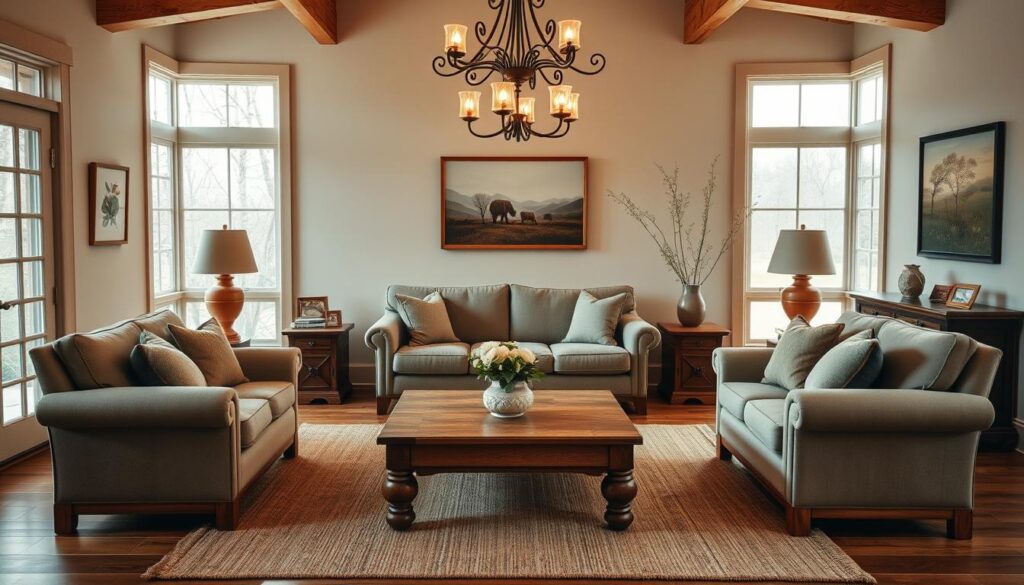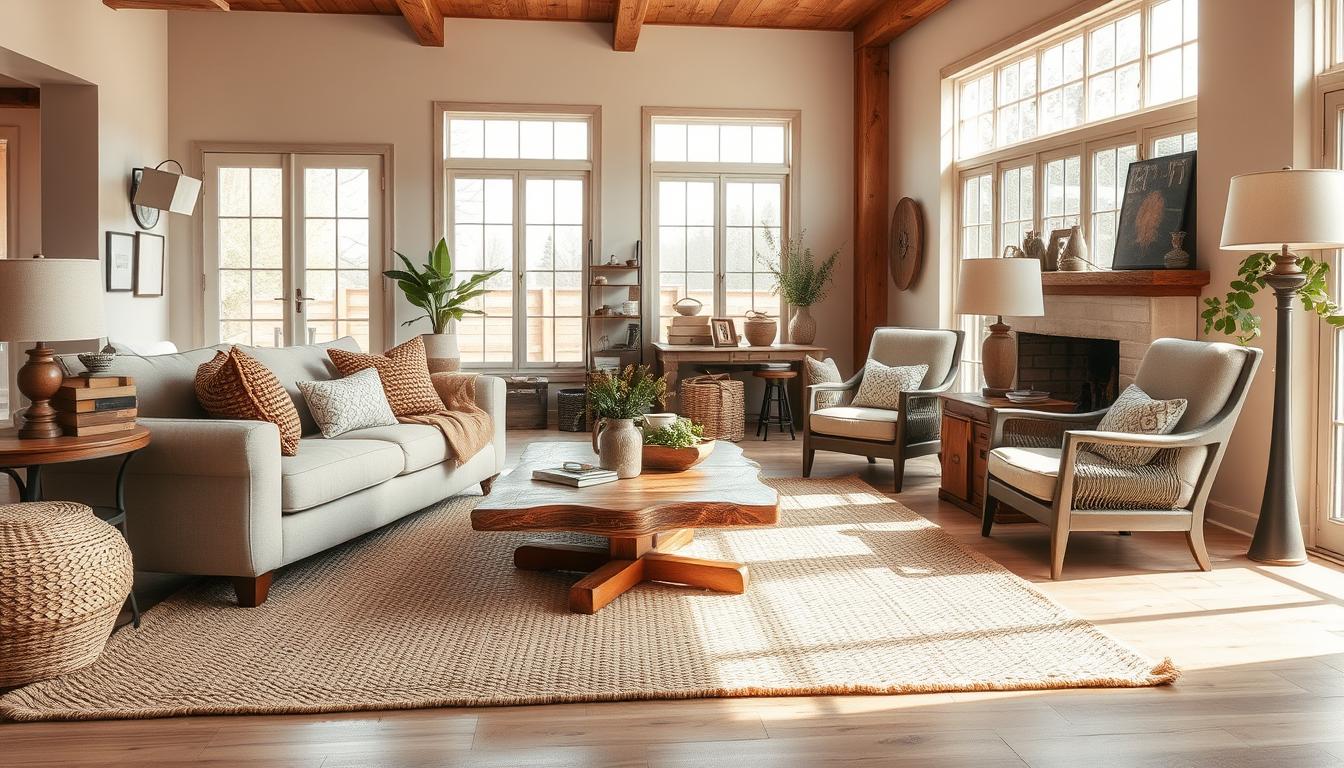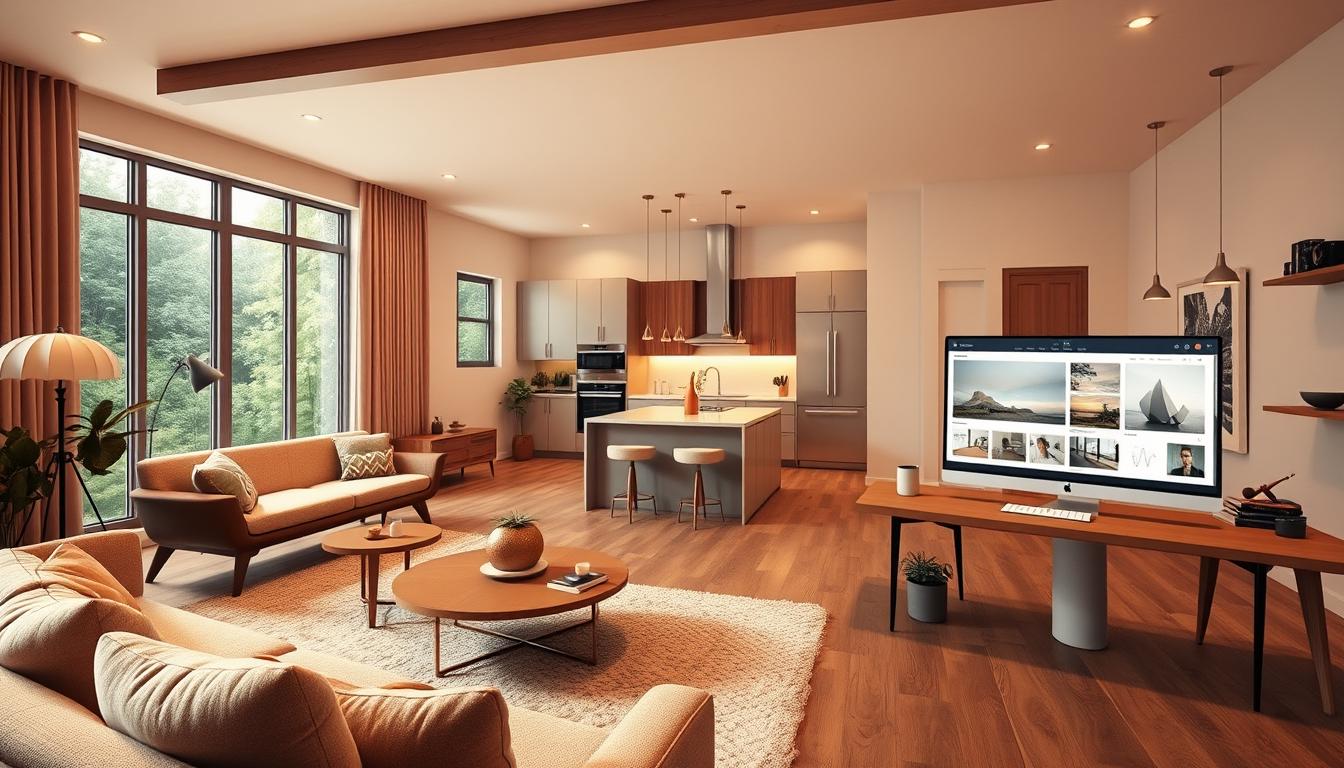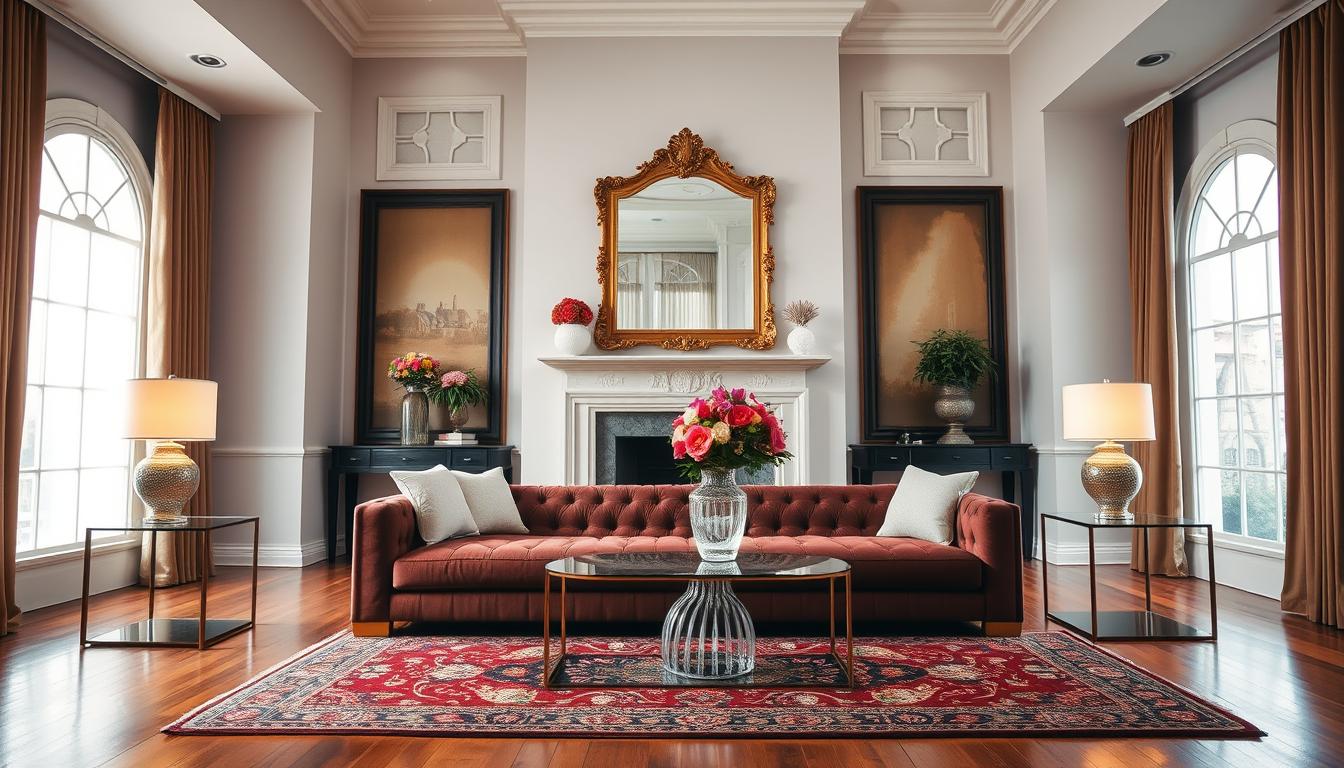Prairie-style homes are known for their warm and inviting feel. They have clean lines and low-sloping roofs that remind us of the Great Plains. This style focuses on horizontal lines and open spaces, making it easy to move between inside and outside.
Frank Lloyd Wright started the Prairie Style home interior design. It brings the outdoors inside, creating a peaceful living space. To learn more, check out the key elements of Prairie Style. These include natural wood finishes and earthy colors.
Key Takeaways
- Emphasis on horizontal lines and open spaces
- Connection to nature through natural materials
- Use of earthy color palettes
- Incorporation of natural lighting
- Seamless blend between indoors and outdoors
Understanding Prairie Style Home Design
Prairie Style home design has its roots in the early 20th century. Architects like Frank Lloyd Wright pioneered this style. It’s a uniquely American architectural movement.
Origins of Prairie Style Architecture
The Prairie Style emerged as a response to America’s changing landscape. Frank Lloyd Wright played a key role in shaping this style. He drew inspiration from America’s vast prairies.
Wright aimed to create harmony between buildings and nature. He used natural materials, low-pitched roofs, and long lines. These elements reflect the prairies’ vastness.
Key Characteristics of Prairie Design
Prairie Style homes stand out for several reasons:
- Low-pitched roofs with overhanging eaves
- Long, horizontal lines that reflect the vastness of the prairies
- Open floor plans that promote a sense of spaciousness and flow
- Use of natural materials such as wood, stone, and brick
- Minimal ornamentation, emphasizing simplicity and functionality
| Characteristic | Description |
|---|---|
| Low-Pitched Roofs | Roofs with a low pitch, often with overhanging eaves, to create a sense of shelter and protection. |
| Horizontal Lines | Long, horizontal lines that echo the vast expanses of the American prairies. |
| Open Floor Plans | Open layouts that promote a sense of spaciousness and fluid movement. |
Notable Prairie Style Architects
Frank Lloyd Wright is famous for Prairie Style architecture. But others, like Purcell and Elmslie, and George Elmslie, also made significant contributions. They designed homes that followed Prairie Style principles.
These architects worked together. They shaped a unique architectural identity. It celebrated American craftsmanship and the beauty of the prairies.
The Essence of Prairie Style Interior Design
Prairie Style interior design blends indoor and outdoor spaces beautifully. It focuses on making the home and nature feel like one. This creates a peaceful and connected living environment.
Open spaces and functionality are key to this design. Homes have open floor plans that make them feel big and easy to move around. This design is not only pretty but also practical and comfy.
Open Spaces and Functionality
Open floor plans are a big part of Prairie Style design. They use fewer walls to make the home feel connected. This also lets more natural light in, making the home feel like it’s part of the outdoors.
The design focuses on being useful and comfortable. Furniture is chosen carefully to fit the space perfectly. This makes the home both beautiful and practical.
Emphasis on Horizontal Lines
Prairie Style design loves horizontal lines. These lines remind us of the wide, flat prairies. They make the home feel stable and connected to the ground.
These lines also make rooms look bigger and more connected to nature. Big windows add to this effect, bringing in the outdoors.
Connection with Nature
A connection with nature is central to Prairie Style design. Using natural materials home decor like wood and stone makes the home warm and welcoming. These materials help link the indoors to the outdoors.
Organic color schemes also play a big role. Colors like greens and browns reflect the prairie’s natural beauty. This choice of colors helps the home feel like it’s part of nature.
Color Palettes in Prairie Style Interiors
The color palette is key in Prairie Style interiors. It sets the tone for a harmonious and natural feel. Earthy tones and natural shades dominate, creating warmth and coziness.
Earthy Tones and Natural Shades
Earthy tones like beige, brown, and green are typical in Prairie Style color schemes. These natural shades blend the indoors with the outdoors. Architects say, “The use of earthy tones in Prairie Style homes is inspired by nature, bringing it inside.”
“The Prairie School style is characterized by its use of natural materials and earthy colors, which creates a sense of harmony with the landscape.”
Accent Colors to Consider
While earthy tones are the base, accent colors like blues and reds add depth and personality. These colors can be used in furniture, rugs, or decorative items. For more ideas on designing a Prairie Style living room, visit Fancy House Design.
Cohesion with Outdoor Views
Creating a connection with nature is a key principle of Prairie Style design. The color palette is crucial in achieving this. Natural shades and earthy tones help blend the indoors with the outdoors. This not only improves the look but also brings calm and well-being.
Furniture Choices for Prairie Style Homes
To truly capture the Prairie Style, choose furniture that’s simple, functional, and nature-inspired. The open floor plan of these homes requires careful furniture selection. This ensures the style’s integrity is maintained.

Custom-Made versus Store-Bought
Homeowners often debate between custom-made and store-bought furniture for Prairie Style homes. Custom-made furniture fits perfectly with the home’s architecture. It’s tailored to the space’s dimensions and needs.
Store-bought furniture is more accessible and budget-friendly. Yet, it’s important to choose pieces that match the Prairie Style’s simplicity and functionality. Look for furniture with clean lines, minimal ornamentation, and natural materials.
Iconic Prairie Style Furniture
Prairie Style furniture is known for its horizontal lines, organic forms, and focus on functionality. Iconic pieces often have built-in cabinetry and sofas with simple designs. These features reflect the style’s architectural roots and contribute to the home’s airy feel.
Some notable examples include:
- Low-profile sofas with clean lines
- Built-in shelving units that emphasize horizontal lines
- Dining tables made from natural woods, with simple leg designs
Arranging Furniture Wisely
The way furniture is arranged in a Prairie Style home is key to its open and welcoming feel. Here are some tips:
- Arrange furniture to complement the home’s architectural features and emphasize horizontal lines.
- Use area rugs to define spaces within the open floor plan while keeping a cohesive look.
- Position furniture to encourage flow and conversation, enhancing the home’s natural lighting and views.
By selecting and arranging furniture thoughtfully, homeowners can keep their Prairie Style home’s interior design intact. They can also create a warm and inviting living space.
Lighting in Prairie Style Interiors
Lighting is key in Prairie Style homes. It highlights architectural features and adds warmth. It’s not just about light; it’s about beauty.
Natural Lighting Considerations
Natural light is vital in Prairie Style interiors. Large windows and clerestory windows let in plenty of light. This reduces the need for artificial light and blends indoors with outdoors.
To get the most natural light, think about your home’s orientation and window placement. Sheer curtains or blinds help control light while keeping privacy.
Types of Lighting Fixtures
Choosing the right lighting fixtures is important. Look for ones that match the style’s natural materials and horizontal lines. Here are some good options:
- Table lamps with natural linen shades
- Floor lamps with simple, geometric designs
- Pendant lights made from natural materials like wood or rattan
Layered Lighting Techniques
Layered lighting uses different light sources for a balanced look. In Prairie Style homes, mix overhead lighting with table and floor lamps. Aim for a balance to avoid harsh shadows and bright spots.
| Lighting Layer | Purpose | Examples |
|---|---|---|
| Ambient Lighting | Provides overall illumination | Ceiling fixtures, natural light |
| Task Lighting | Illuminates specific areas for tasks | Table lamps, under-cabinet lighting |
| Accent Lighting | Highlights architectural features or decor | Picture lights, LED tape lights |
By using layered lighting and the right fixtures, you can make your Prairie Style home more welcoming. It will feel more connected to the outdoors.
Textiles and Patterns in Prairie Style
Textiles and patterns add warmth and character to Prairie Style interiors. They reflect the style’s focus on natural and minimalist design. Choosing the right fabrics and patterns can make a room feel cozy and connected to nature.

Recommended Fabrics for Authenticity
To keep a Prairie Style interior true to form, use natural fabrics like wool, linen, and cotton. These materials are comfortable and match the style’s natural and simple vibe. Natural fibers are great because they last long and look good, adding to the space’s harmony.
Colorful Patterns that Compliment
Prairie Style interiors often feature designs inspired by nature. Geometric patterns, botanical prints, and soft textures are favorites. Earth tones and muted colors are key, making sure patterns fit well with the design.
Textiles that Enhance Comfort
Textiles in Prairie Style homes are about more than looks; they make spaces cozy. Think plush rugs, comfy upholstery, and soft throw blankets. These items add warmth while keeping the style’s minimalist feel. Choose textiles that are both useful and pleasing to the eye, making the space welcoming.
By picking textiles and patterns that fit Prairie Style design, homeowners can create beautiful and cozy interiors. This way, living spaces feel connected to nature and show off the timeless beauty of Prairie Style.
Creating a Seamless Indoor-Outdoor Flow
Prairie Style architecture is known for blending indoors and outdoors. This design makes homes look better and adds more space by bringing the outdoors inside.
Designing Access to Nature
To make indoor and outdoor spaces feel connected, we need to design access to nature well. We can do this with wide paths, smartly placed doors, and outdoor areas that match the indoors. This creates an open floor plan design that links the two seamlessly.
Using big sliding glass doors or French doors helps a lot. They make moving between inside and outside easy. They also connect us visually to nature.
Utilizing Large Windows
Big windows are key in Prairie Style homes. They connect the indoors to the outdoors. This makes the space feel bigger and lets in lots of natural light, which is great for earthy tones interior design.
Placing windows right can also make the outdoors part of the decor. This makes the space look better and helps us feel closer to nature.
| Design Element | Purpose | Benefit |
|---|---|---|
| Large Windows | Bring the outdoors in | Expands living space visually |
| Sliding Glass Doors | Connect indoor and outdoor spaces | Enhances flow and accessibility |
| Outdoor Living Spaces | Extend indoor living areas | Increases functional living space |
Outdoor Living Spaces as Extensions
Outdoor living spaces are key to a seamless indoor-outdoor flow. By making these areas part of the indoor living space, we can make our homes bigger. This can include outdoor kitchens, dining, or just comfy seating that matches the indoors.
It’s important to make these outdoor spaces match the indoors. Using the same design and materials makes the home look better and feel more livable.
Accessories and Decor in Prairie Style
In Prairie Style homes, choosing the right accessories and decor is key. It keeps the style simple and connected to nature. The right picks can make the space more beautiful while staying true to the design.
Selecting Appropriate Artwork
Artwork in Prairie Style homes should match the natural look. Pick pieces that show nature’s beauty or abstract designs that fit the style. Choose artwork with earthy tones to blend with the color scheme.
Incorporating Natural Elements
Adding natural elements is a big part of Prairie Style decor. Use reclaimed wood, stones, or plants to add texture and warmth. These elements also connect the indoors to the outdoors.
Maintaining Simplicity in Decor
Simplicity is a core principle of Prairie Style. When decorating, find a balance between adding character and keeping things simple. Avoid clutter and choose a few decorative pieces that enhance the space without overwhelming it.
By picking the right artwork, adding natural elements, and keeping decor simple, we can make a Prairie Style home. It will be both beautiful and true to its organic and craftsman style roots.
Tips for Modernizing Prairie Style Interiors
To update Prairie Style interiors, mix modern touches with the classic look. We can make a space both unique and useful by using eco-friendly materials and adding personal touches.
Blending Contemporary Elements
Modernizing Prairie Style homes means adding sleek lights, modern furniture, and bold art. This mix of old and new creates a balanced look. It blends traditional Prairie Style with modern decor.
Sustainable Materials and Designs
Using eco-friendly materials is key to updating Prairie Style homes. Choose reclaimed wood, low-VOC paints, and energy-saving appliances. This helps reduce our impact on the environment.
Personal Touches and Customization
Adding personal elements makes a Prairie Style home truly yours. Include family treasures, custom art, or unique furniture. These touches enhance the modern Prairie Style decor.


